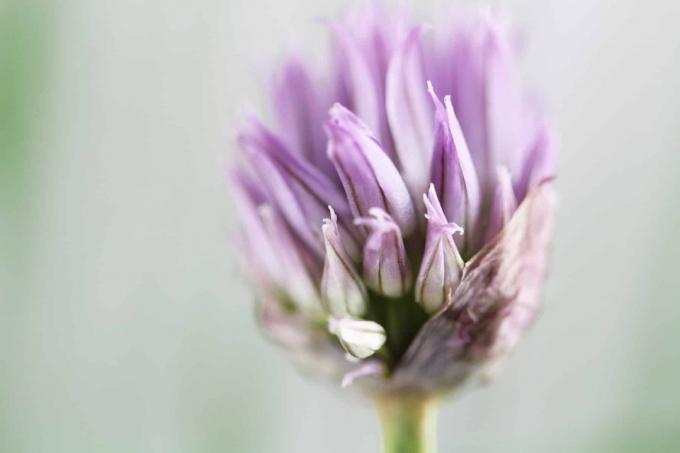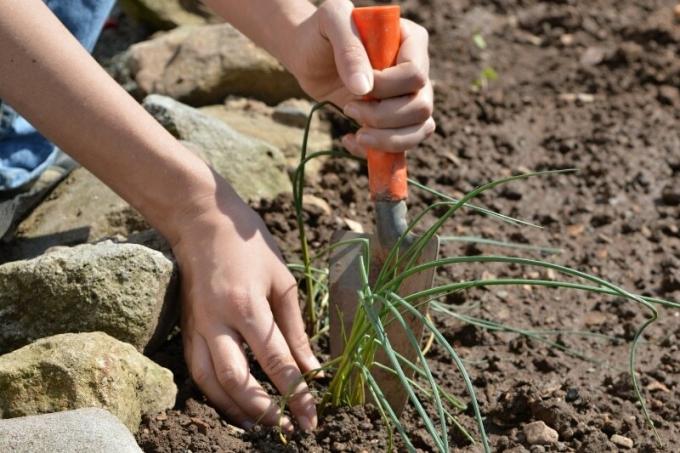
Chives are healthy and tasty. Hobby cooks can't get enough of them, after all, the green tubes go well with many dishes. We explain step by step how to propagate chives by seed and division.
In a nutshell
- Chives can be propagated in different ways
- Culinary herbs can be propagated by seeds
- Are contained in purple flowers
- Propagation by division faster and more effectively
- Sow in spring and divide in autumn
Table of contents
- Propagating chives by seed
- Propagate chives by division
- frequently asked Questions
Propagating chives by seed
harvest seeds

Chives (Allium schoenoprasum) forms in May violet flowers, which consist of a large number of small individual flowers. This is where the seeds mature. How to get the seeds:
- leave some flowers on the plant
- Cut off wilted and brownish flowers (indication of seed maturity).
- lay on kitchen paper or newspaper to dry (change the underlay after three days)
- Seed pods open after about a week
- Remove the remains of the flowers and remove the dry seeds from the base
- Store seeds in a dry, sealable container until spring
Tip: Seeds of different herbs can hardly be distinguished with the naked eye. Carefully label the containers with the plant name and date.
sow chives
From April you can Chive seeds in pots or sow directly into the bed. Choose a suitable location. Chives ideally thrive in a sunny to partially shaded spot. Humus-rich, well-drained soil is important.

This is the best way to sow:
- Loosen up the bed and remove weeds and stones.
- Mix compost into the soil and then rake the area smooth.
- Now press grooves about two centimeters deep into the ground at a distance of 25 centimeters.
- Sow about two seeds per inch in the grooves.
- Close the row of seeds with soil and press down on both sides with the back of the rake.
- Water the bed carefully. Use a watering can with a spray attachment.
- To protect the seed and to accelerate germination, stretch a translucent film over the bed, which you ventilate daily.
- Remove the foil as soon as the cotyledons appear.
A notice: If you leave some flowers on the plant for seed formation, your chives will also self-seed. The young plants then appear in the same place the next year.
Propagate chives by division

Usually, however, chives are not propagated by seed, but by division. The method is quick and easy. The best time is autumn. The best way to do this is as follows:
- Trim the chives before dividing. After that, refrain from watering for about two weeks.
- Dig up the chive plant.
- Using a sharp knife, scissors, or small shovel, divide the root ball into two or three parts.
- Dig planting holes for the divided plants and place them in.
- Fill in the soil and water the chives vigorously.
- Make sure the substrate stays moist. However, waterlogging should be avoided.
frequently asked Questions
We recommend dividing chive plants only every two years. The plant needs a lot of energy to recover after division.
Both methods have advantages. The sowing produces a multitude of new chive plants. However, you will have to wait until next spring to sow self-gathered seeds. The division is faster and less complicated. If you have particularly beautiful plants, you should try this method.
You can harvest chives from March to October. To do this, cut the stems about two centimeters above the ground. Never remove more than a third of the chives. This allows it to recover well and quickly forms new stems.
Water the plants regularly. The soil should not dry out. Fertilize with compost. Important is, Cut chives regularly. This is the only way to constantly form new shoots. Chives are hardy and can remain in the bed all year round. As long as there is no frost, you should water the plants from time to time, even in winter.

